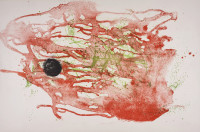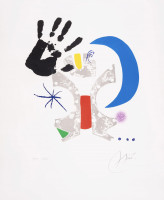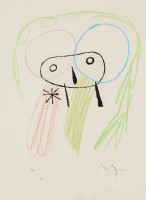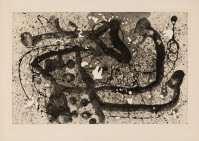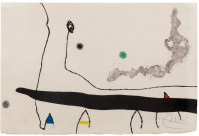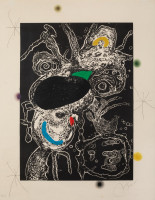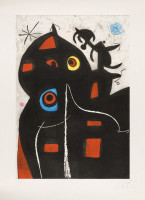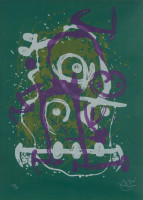
Details
Artist
Styles
Color drypoint and cement imprint - Published by Maeght, Paris - In Excellent Condition - Signed and numbered in pencil - Literature: Dupin 451 // Emehpylop by Joan Miró, created in 1968, is a limited edition color drypoint print that highlights Miró’s distinct abstract style. The composition features a large, black, textured form at the center resembling a head or mask, surrounded by whimsical, gestural lines and colorful orbs in shades of blue, orange, green, and yellow. The black form is marked by intriguing patterns and shapes, while the surrounding lines and scattered colors create a sense of dynamic movement and playfulness. Miró’s signature abstract, surrealist style is evident in this piece, with its mixture of organic shapes and childlike spontaneity. The delicate balance of form, color, and texture makes this work visually captivating, embodying Miró’s imaginative approach to art.
Emehpylop, 1968
form
Medium
Size
68.6 x 50.8 X 4.6 cm
- Inches
- Centimeters
Edition
Price
- USD
- EUR
- GBP
Details
Artist
Styles
Color drypoint and cement imprint - Published by Maeght, Paris - In Excellent Condition - Signed and numbered in pencil - Literature: Dupin 451 // Emehpylop by Joan Miró, created in 1968, is a limited edition color drypoint print that highlights Miró’s distinct abstract style. The composition features a large, black, textured form at the center resembling a head or mask, surrounded by whimsical, gestural lines and colorful orbs in shades of blue, orange, green, and yellow. The black form is marked by intriguing patterns and shapes, while the surrounding lines and scattered colors create a sense of dynamic movement and playfulness. Miró’s signature abstract, surrealist style is evident in this piece, with its mixture of organic shapes and childlike spontaneity. The delicate balance of form, color, and texture makes this work visually captivating, embodying Miró’s imaginative approach to art.
- Recently Added
- Price (low-high )
- Price (high-low )
- Year (low-high )
- Year (high-low )
Joan Miró
Untitled (from The Bouquet De Rêves Pour Neila Portfolio), 1967
Limited Edition Print
Lithograph
USD 2,950
Joan Miró
Untitled (from The La Bague D’Aurore Portfolio), 1957
Limited Edition Print
Mixed Media
USD 14,850
Joan Miró
Le Marteau Sans Maître: One Plate, 1976
Limited Edition Print
Etching And Aquatint
USD 4,880
Joan Miró
Invitation Card For The Opening Of The Fundació Miró Barcelona, 1976
Limited Edition Print
Lithograph
USD 4,250
Joan Miró
Untitled 3 From Maravillas Con Variaciones Acrósticas , 1975
Limited Edition Print
Lithograph
Inquire For Price
Joan Miró
Untitled 2 From Maravillas Con Variaciones Acrósticas , 1975
Limited Edition Print
Lithograph
USD 5,460
Joan Miró
Untitled 1 From Maravillas Con Variaciones Acrósticas , 1975
Limited Edition Print
Lithograph
Inquire For Price
Joan Miró
Plate 8, From Lézard Aux Plumes D'or, 1967
Limited Edition Print
Lithograph
Inquire For Price
Joan Miró
Le Lézard Aux Plumes D'or (book), 1971
Limited Edition Print
Lithograph
EUR 28,000 - 35,000
Joan Miró
Serie Mallorca - Negro Y Blanco IX, 1973
Limited Edition Print
Etching And Aquatint
EUR 8,350
Joan Miró
Serie Mallorca - Negro Y Blanco VII, 1973
Limited Edition Print
Etching And Aquatint
EUR 8,350
Joan Miró
Serie Mallorca - Negro Y Blanco VI, 1973
Limited Edition Print
Etching And Aquatint
EUR 8,350
Joan Miró
Serie Mallorca - Negro Y Blanco I, 1973
Limited Edition Print
Etching And Aquatint
EUR 8,350
Joan Miró
Untitled, From Album 21 Portfolio - M1136, 1978
Limited Edition Print
Lithograph
USD 6,250
Joan Miró
Untitled, From Album 21 Portfolio - M1130, 1978
Limited Edition Print
Lithograph
USD 6,250
Joan Miró
Demi Mondaine A Sa Fenetre - D742, 1975
Limited Edition Print
Etching And Aquatint
USD 7,200
Joan Miró
Chevauchée - Vert Violet Brun, 1969
Limited Edition Print
Lithograph
Currently Not Available
Joan Miró
Untitled (from Quelques Fleurs Pour Des Amis), 1964
Limited Edition Print
Lithograph
Currently Not Available
Joan Miró
Untitled (from Les Demeures D'hypnos Portfolio), 1976
Limited Edition Print
Lithograph
Currently Not Available
What is late modernism?
Late Modernism refers to the continuation and evolution of Modernist principles in art, architecture, and literature from the mid-20th century into the late 20th century. This movement maintains a focus on form, abstraction, and the rejection of traditional styles, but it often incorporates more complexity and ambiguity compared to early Modernism. Late Modernism explores themes such as alienation, identity, and the fragmentation of reality, reflecting the social and cultural shifts of the post-war period. It is seen in the works of architects like Louis Kahn and artists like Francis Bacon, who pushed the boundaries of Modernism while responding to the changing world around them.








